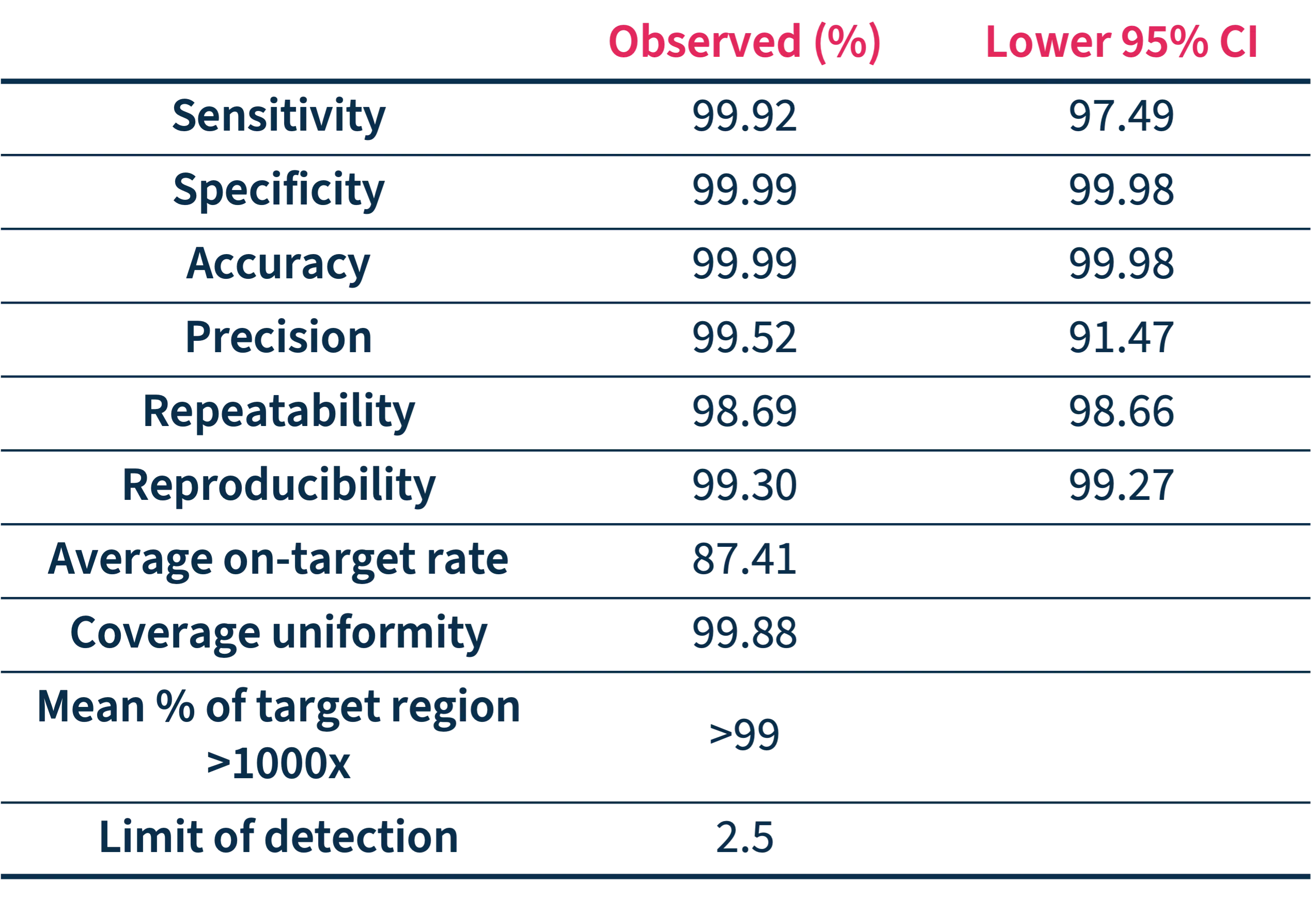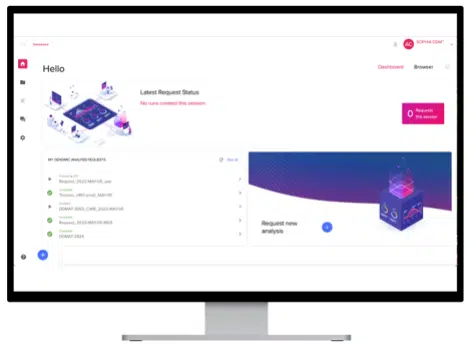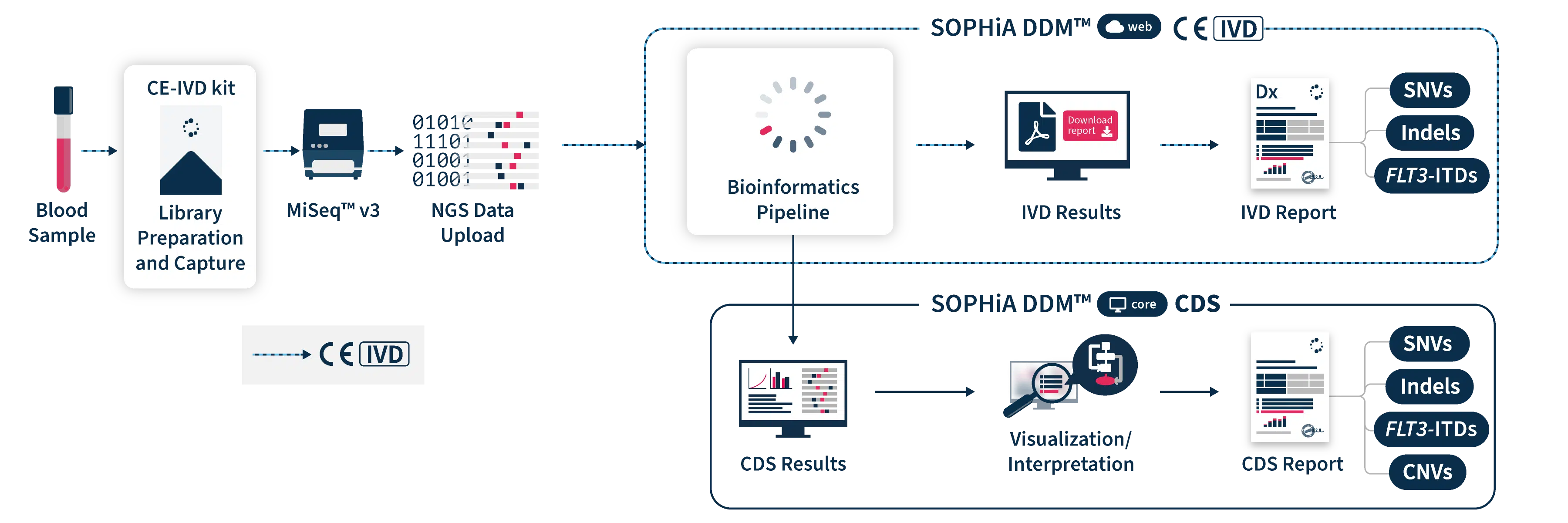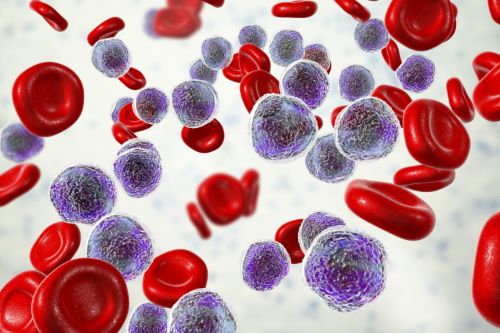SOPHiA DDM™ Dx Myeloid Solution
From myeloid neoplasms genetic ethiology to care management
Accurate detection and reporting of biomarkers associated with blood cancers are critical for better patient management.
SOPHiA DDM™ Dx Myeloid Solution (MYS) is a CE-marked in vitro diagnostic (IVD) application based on next-generation sequencing (NGS) enabling accurate and sensitive characterization of the complex mutational landscape associated with myeloid neoplasms. Powered by the advanced analytical capabilities of SOPHiA DDM™ Platform, this sample-to-report application helps healthcare professionnals increase their efficiency and confidence of getting actionable clinical insights and making data-driven decisions that improve the quality of patient care.
Tailored analytics to accurately detect SNVs and Indels in 30 genes involved in blood cancers, including FLT3-ITDs
Reduced turnaround time with a ready-to-sequence target-enriched library in just 2 days
CE-IVD marked SOPHiA DDM™ Platform web for intuitive reporting with unlimited and safe data storage
Product Details
Accurately detect actionable variants
SOPHiA DDM™ Dx MYS accuracy has been assessed through a multicenter performance evaluation study* showing:
• High on-target rates and coverage uniformity, even in GC-rich regions
• High-confidence calling of SNVs and Indels in 30 targeted genes
• Clinical-grade analytical performance that can facilitate confident decision-making.
*Performance values have been calculated based on 237 samples processed in 5 sequencing centers on Illumina MiSeq™.


Confidently generate comprehensive reports
SOPHiA DDM™ Dx MYS includes direct access to SOPHiA DDM™ Platform web, a front-end application to upload and analyze genomic sample data and generate downloadable CE-IVD reports. It offers unlimited and unrestricted storage, while keeping patient data safe by applying the highest industrial standards of encryption in compliance with local data security policies.

Easily interpret clinically relevant variants
SOPHiA DDM™ Dx MYS also offers an additional component via SOPHiA DDM™ Platform core that allows users to visualize, interpret and report key biomarkers. Clinical Decision Support (CDS*) results are computed by the bioinformatics pipeline in a single workflow. CDS* reports include SNVs, Indels and CNVs for the 30 targeted genes and can be tuned via intuitive cascading filters and prioritization options based on databases, in-house machine learning predictions, virtual panels or custom filters. Users also have access to SOPHiA GENETICS™ Community to share valuable knowledge with peers.
Specifications
| Parameters | SOPHiA DDM™ Dx Myeloid Solution |
|---|---|
| Diseases Covered | Myelodysplastic syndromes, myeloproliferative neoplasms and leukemia |
| Genes | 30 genes (ABL1, ASXL1, BRAF, CALR, CBL, CEBPA, CSF3R, DNMT3A, ETV6, EZH2, FLT3, HRAS, IDH1, IDH2, JAK2, KIT, KRAS, MPL, NPM1, NRAS, PTPN11, RUNX1, SETBP1, SF3B1, SRSF2, TET2, TP53, U2AF1, WT1, ZRSR2) |
| Key Biomarkers | ASXL1, CALR, CEBPA, FLT3 including internal tandem duplications |
| Sample Type | Blood |
| DNA Input Amount | 200 ng |
| Sequencer Compatibility | Illumina MiSeq™ |
| Library Preparation Time | 2 days |
| Analysis Time From FASTQ | > 6 hours |
| Detected Variants |
|
| Product type | Molecular diagnostic application (kit + analytics) |
Resources
Fact sheet
Contact us
Please fill out the form below to get in touch
Related products
SOPHiA DDM™ Blood Cancers Applications
Expand the scope of myelodysplastic syndromes, myeloproliferative neoplasms and leukemia management with our targeted genomic applications.

CE-IVD Oncology Applications by SOPHiA GENETICS™
Transform raw NGS data into actionable insights with our CE-marked in vitro diagnostic (IVD) applications.

CNVs, copy number variants; Indels, insertions and deletions; ITDs, internal tandem duplications; SNVs, single nucleotide variants
*CDS – For Clinical decision support use only – not intended as a primary diagnostic tool